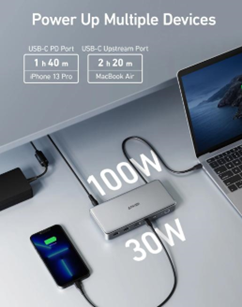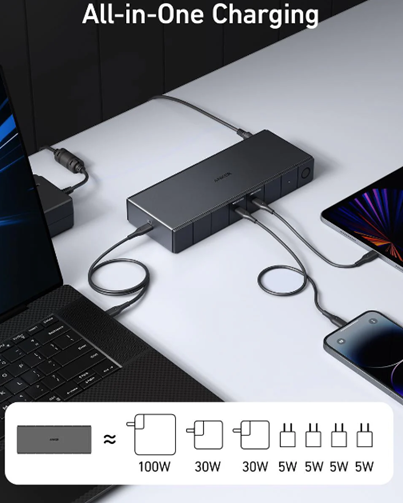Setting up a new docking station can streamline your workspace and
enhance productivity. To make the process smooth and efficient, you need to
follow some essential steps. These steps involve preparing the right setup
environment, ensuring compatibility with your devices, and optimizing
performance through proper maintenance. Whether you're a first-time user or
upgrading your current setup, these tips will help you avoid common pitfalls
and get the most out of your docking station. This guide will walk you through
the crucial considerations before setup, the proper way to connect your docking
station, the accessories that can enhance your experience, and how to maintain
it for optimal performance.

What Should You Consider Before Setup?
Choosing the Right Location
Selecting the right location for your docking station is crucial.
Ensure the spot you choose has easy access to power outlets and is within reach
of all the devices you plan to connect. Avoid placing it in areas with
excessive heat or direct sunlight to prevent overheating. Additionally,
consider the proximity to your primary workspace to minimize cable clutter and
ensure that all cables can reach their respective ports without strain. An
ideal location is one that balances accessibility, safety, and aesthetics,
providing a seamless integration into your workspace.
Ensuring Compatibility with Your Devices
Before setting up your docking station, confirm its compatibility
with your existing devices. Check the specifications of your laptop or desktop
and compare them with the docking station’s requirements. Ensure that your
devices support the necessary ports, such as USB-C, HDMI, or Thunderbolt. It's
also important to verify that your operating system is compatible with the
docking station’s drivers and software. This step will prevent any connectivity
issues and ensure that your docking station can provide the expected
performance and functionality without any technical hitches.
How to Properly Connect Your Docking Station?
Step-by-Step Connection Guide
Connecting your docking station involves a few straightforward
steps. First, plug in the docking station’s power adapter and connect it to a
power source. Next, connect the docking station to your laptop or desktop using
the appropriate cable, typically a USB-C or Thunderbolt cable. Once connected,
plug in your peripheral devices, such as monitors, keyboards, and mice, into
the corresponding ports on the docking station. Finally, turn on your laptop or
desktop, and install any necessary drivers or software updates to ensure full
functionality.
Troubleshooting Common Issues
If you encounter issues during setup, start by checking all cable
connections to ensure they are securely plugged in. Restart your computer and
the docking station to reset the connection. If peripherals are not recognized,
verify that the docking station’s drivers are correctly installed and up to
date. Check the manufacturer’s website for any firmware updates that may
resolve compatibility issues. If the problem persists, consult the user manual
or reach out to customer support for further assistance. Ensuring that all
components are compatible and properly connected is key to avoiding setup
issues.
What Accessories Will Enhance Your Docking Station Experience?
Must-Have Cables and Adapters
To maximize the functionality of your docking station, invest in
high-quality cables and adapters. Essential cables include HDMI or DisplayPort
cables for connecting external monitors, and USB-C or Thunderbolt cables for
ensuring high-speed data transfer. Additionally, having spare power cables and
adapters on hand can prevent interruptions during critical tasks. Choose cables
and adapters that match the specifications of your docking station and devices
to ensure optimal performance and durability. The Reliable accessories from
Anker can enhance connectivity and reduce the likelihood of technical issues.

Recommended Peripheral Devices
Enhance your docking station setup with peripheral devices that
boost productivity and convenience. A high-resolution monitor can expand your
workspace and improve multitasking. An ergonomic keyboard and mouse can provide
comfort during long working hours. Consider adding an external hard drive for
additional storage and backup solutions. Quality speakers or headphones can
enhance audio experiences for meetings and entertainment. By selecting
peripherals that complement your docking station, you can create a versatile
and efficient workspace tailored to your needs.
How to Optimize Performance and Maintain Your Docking Station?
Regular Maintenance Tips
Regular maintenance is essential for the longevity and performance
of your docking station. Keep the docking station and connected devices clean
and dust-free by using a soft cloth. Avoid using harsh chemicals that may
damage the surfaces. Periodically check all cable connections to ensure they
are secure and in good condition. Unplug the docking station during electrical
storms to prevent damage from power surges. Performing these routine
maintenance tasks will help prevent issues and prolong the life of your
equipment.
Software and Firmware Updates
Keeping your docking station’s software and firmware updated is
crucial for optimal performance. Check the manufacturer’s website regularly for
updates that may address bugs, improve compatibility, or add new features.
Install updates as soon as they become available to ensure your docking station
operates efficiently. Additionally, ensure that your operating system and
connected devices have the latest updates. Staying current with software and
firmware updates helps maintain the docking station’s functionality and
compatibility with other devices.
Conclusion
Setting up your new docking station involves careful planning and attention to detail. By choosing the right location, ensuring compatibility, and following proper connection procedures, you can create an efficient and organized workspace. Enhancing your setup with the right accessories and maintaining your docking station through regular updates and cleaning will optimize its performance. Follow these essential tips to enjoy a seamless and productive experience with your new Anker product, which can provide the best docking station.
